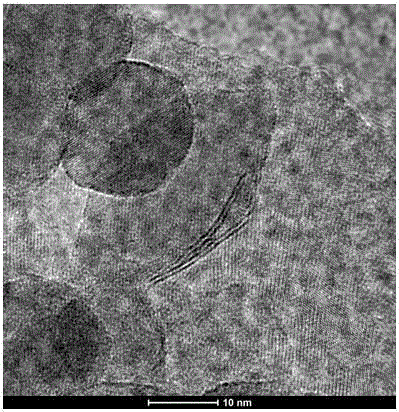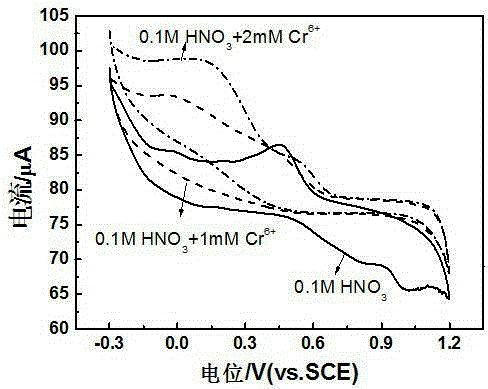Preparing method of molybdenum sulfide compound and application of molybdenum sulfide compound in detecting hexavalent chromium in water
A molybdenum sulfide and compound technology is applied in the field of environmental detection to achieve the effects of high sensitivity, low cost and improved catalytic performance
- Summary
- Abstract
- Description
- Claims
- Application Information
AI Technical Summary
Problems solved by technology
Method used
Image
Examples
1 example 1
[0040] 1. At room temperature, weigh ferric chloride hexahydrate and ferrous chloride tetrahydrate and dissolve them in deionized water, stir in nitrogen for 20 minutes to obtain solution 1; the rate of feeding nitrogen is 100-200 ml / min.
[0041] 2. Keep the ratio of the amount of the two solutes in solution 1 as 1 / 3.
[0042] 3. Continue to feed nitrogen, heat the solution in a water bath from 1 to 60°C and keep it for 5 minutes; the rate of feeding nitrogen is 100-200 ml / min.
[0043] 4. Under the protection of nitrogen, slowly add ammonia water with a concentration of 1.5 mol / L to solution 1 until the pH is 7.5; the rate of feeding nitrogen is 100-200 ml / min.
[0044] 5. Then aging the above mixed solution at 70°C for 20-40 minutes.
[0045] 6. After the reaction, magnetically separate to obtain ferric oxide, and wash the obtained ferric oxide with deionized water for 5 times until the pH of the solution is within the range of 7.0.
[0046] 7. Transfer the separated iron...
2 example 2
[0058] 1. At room temperature, weigh ferric chloride hexahydrate and ferrous chloride tetrahydrate and dissolve them in deionized water, stir in nitrogen for 20 minutes to obtain solution 1; the rate of feeding nitrogen is 100-200 ml / min.
[0059] 2. Keep the ratio of the amount of the two solutes in solution 1 as 1 / 4.
[0060] 3. Continue to feed nitrogen, heat the solution in a water bath from 1 to 60°C and keep it for 10 minutes; the rate of feeding nitrogen is 100-200 ml / min.
[0061] 4. Under the protection of nitrogen, slowly add ammonia water with a concentration of 1.5 mol / L to solution 1 until the pH is 7.5; the rate of feeding nitrogen is 100-200 ml / min.
[0062] 5. Then aging the above mixed solution at 60° C. for 30 minutes.
[0063] 6. After the reaction, magnetically separate to obtain ferric oxide, and wash the obtained ferric oxide with deionized water 8 times until the pH of the solution is within the range of 7.0.
[0064] 7. Transfer the separated iron fer...
PUM
| Property | Measurement | Unit |
|---|---|---|
| Particle size | aaaaa | aaaaa |
| Diameter | aaaaa | aaaaa |
Abstract
Description
Claims
Application Information
 Login to View More
Login to View More - R&D
- Intellectual Property
- Life Sciences
- Materials
- Tech Scout
- Unparalleled Data Quality
- Higher Quality Content
- 60% Fewer Hallucinations
Browse by: Latest US Patents, China's latest patents, Technical Efficacy Thesaurus, Application Domain, Technology Topic, Popular Technical Reports.
© 2025 PatSnap. All rights reserved.Legal|Privacy policy|Modern Slavery Act Transparency Statement|Sitemap|About US| Contact US: help@patsnap.com



